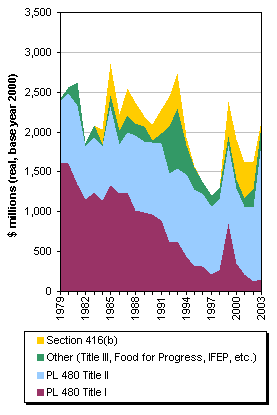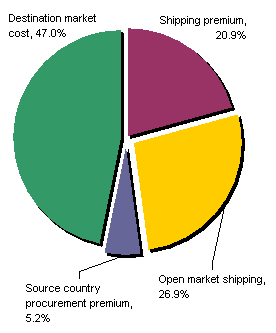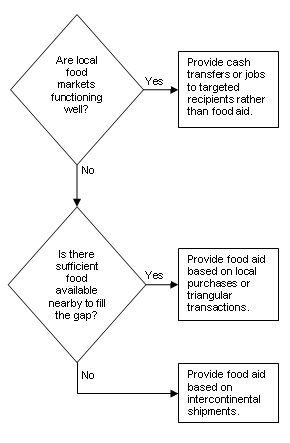|
Fifty years ago, President Eisenhower signed the Agricultural Trade Development and Assistance Act of 1954 into law as US Public Law 480, commonly known as PL480. Global food aid programs, the largest of which is PL480, have brought together governments, businesses, multilateral institutions such as the World Food Programme (WFP), and American private voluntary organizations (PVOs) in a valuable public-private partnership intended to reduce hunger and suffering around the world. Over the past half century, PL480 programs alone have contributed more than 340 million metric tons of food aid to save and improve the lives of hundreds of millions of poor and hungry people around the world.
At least 30 different nations—two thirds of them in sub-Saharan Africa—currently lack food supplies sufficient to meet basic minimum food-consumption standards for their whole population. When food availability from local production and commercial imports is insufficient—as most commonly occurs in acute emergencies—food aid fills a crucial gap, thereby contributing to economic development and the protection of basic human rights. However, if used inappropriately or managed poorly, food aid can undermine agricultural production, market development, and international trade, thus impeding economic development and human rights.
Because it helps substantially some places and causes damage in others, food aid is contentious. Food aid is accused of causing producer disincentives in low-income countries and of disrupting commercial trade, and it is a focal point for disagreement over genetically modified foods in the midst of humanitarian crises. These disagreements largely result from donor-country policies that misuse food aid for purposes for which it is demonstrably ineffective: to support domestic farm prices, to promote commercial agricultural exports, to advance geostrategic aims, and to maintain a viable maritime industry. The futile use of food aid to pursue donor self-interests also causes food aid to underperform its potential to provide food to places where availability is insufficient and markets don't deliver it reliably and quickly enough to protect human lives. A sensible strategy of reform can meet agricultural and maritime interests, and, by reducing the waste in a system serving too many political masters at once, make food aid a more effective tool for advancing development and humanitarian objectives.
The Current Status of Food Aid
The prevailing model of transoceanic food aid shipments was born in the 1950s and 1960s, when generous farm price support programs for North American farmers generated large government stockpiles of food. Much of this food was channeled overseas as government-to-government food-aid shipments, commonly known as "program" food aid. Recipient governments usually sold the food on the open market and used the proceeds for other activities. Over the past 20 years, as donor governments' farm policies have evolved, reducing or eliminating most public food stockpiles, program food aid has waned. Project food aid, in support of local interventions run by PVOs or by the WFP, has been commonplace since the 1970s. Over the past 15 years, emergency food aid, in response to natural disasters and complex political emergencies, has become the predominant form of food aid, usually in the form of free distribution to acutely hungry people, including refugees and internally displaced persons. US food aid programs demonstrate this pattern. As Figure 1 shows, program food aid (Title I) has declined more than 90% since 1980 in inflation-adjusted terms, while emergency and project food aid under Title II have increased significantly since the end of the Cold War in 1989-1990, when food security was made a formal objective of American food aid.
Since government food stockpiles are largely a thing of the past, most US food aid is now purchased through government procurement systems. Registered vendors earn a slight premium above prevailing market prices. However, at an annual value of about $2 billion, US food aid programs are too small to have any major effect on the general prices America's farmers receive in an economy where annual food expenditures top $900 billion. Econometric studies also find that food aid fails to promote subsequent years' American commercial agricultural exports, as the original proponents of PL480 had intended. Consequently, outside of a very few niche commodities and processors, food aid generally fails to boost the prices received by American farmers and agribusinesses, and it doesn't expand overseas markets for their products. European nations, realizing this, have largely decoupled food aid programs from their bloated domestic farm support programs over the past decade. The United States has been slow to follow suit.
Direct distribution of food to individuals is necessary but insufficient to stem suffering and to achieve lasting social and economic development. To eliminate hunger in a world of plenty, the international community must commit itself to combating poverty itself, not simply to making food available. However, it is unrealistic to expect to find additional public funding for this strategically important goal. So, we must use existing resources more wisely to increase the return per tax dollar invested. This situation requires both policy changes by the donor country governments that provide food aid and operational changes by the agencies that distribute it.
Policy Changes Needed
Simply put, doing well is not enough. We can do better. As the world's largest food aid donor by far, the United States could help more people, in a more timely fashion, at lower cost to American taxpayers, if the Congress would make a few key changes to the current system.
Negotiate a new Global Food Aid Compact to replace the expired Food Aid Convention. The Food Aid Convention (FAC) was an agreement among donor countries to ensure a minimum volume of food aid that did not disrupt commercial trade. Lacking monitoring or enforcement capacity, it languished. A new Global Food Aid Compact (GFAC) should replace the FAC. The GFAC would give recipient country governments and the agencies that distribute food aid explicit responsibilities under an international code of conduct that would strengthen accountability, effectiveness, fairness, and transparency. By committing donor countries not only to traditional tonnage minima, but also to provision of adequate complementary financial resources and to some relaxation of rules mandating donor-country procurement, processing, and shipping services, a GFAC could enable humanitarian and development agencies to bring appropriate resources to bear in any given context in an economical and timely fashion. Moreover, by linking a GFAC to the next WTO agreement—as endorsed by international experts in the September 2003 Berlin Statement—there could finally be effective disciplines to reduce trade-related disputes over food aid.
Eliminate unnecessary bureaucratic duplication. Consolidating the federal government's six different food aid programs now run through two different agencies (USAID and USDA) into a single program would yield a more streamlined food-aid system that would be less costly and less wracked by conflicting objectives and institutional incentives that impede effective use of food aid resources.
Focus on emergencies and make the response quicker and more flexible. Food aid has its most important impact in saving lives in emergencies where there is an outright shortfall in food availability and where markets do not function adequately. However, shipping food across oceans is expensive and slow. As Figure 2 shows, each dollar appropriated for food aid generates an average of less than fifty cents of food. The most sizable additional cost is for shipping, made more costly by lavish subsidies of 75% or more to freight lines under provisions of the Cargo Preference Act, a relatively obscure law enacted alongside PL480 in 1954 to support America's merchant marine fleet. This is 60% more than it costs European donors that commonly procure food closer to ultimate distribution points and significantly more than the Canadians pay to ship food from North America without big, hidden subsidies to the maritime industry.
Intercontinental shipments also are slow. It takes more than five months, on average, for US emergency shipments to reach their destination. Delays and high transport expenses cost lives. Much needless suffering and unnecessary expense could be reduced if during the initial months of an acute humanitarian emergency, the USAID administrator had authority to procure and process food aid in developing countries, closer to ultimate distribution points. Only about 10% of global food aid is procured in developing countries, but typically at lower cost and greater timeliness in deliveries. Food aid programs need to move further in this direction. Sensible reforms would also require decoupling government support for shipping from humanitarian programming and instead bundling such subsidies into existing maritime support programs up for Congressional renewal in 2006.
Within current budgets, adapt the resource to fit the application. Over the years, it has become clear that although direct distribution of food can address acute hunger in emergencies, it is not sufficient to address the causes of hunger. Almost 60% of PL480 resources—and most other US food aid shipments—are not for emergencies. To increase the flexibility of food aid, the US government permits the sale of food in recipient countries to generate cash resources for other programs addressing the causes of hunger—a practice known as monetization. Monetized food has been a valuable, flexible resource that many PVOs have put to good use in combating poverty and hunger over the years. Levels of monetization of nonemergency Title II food aid have increased dramatically in the past decade, from 10% in 1991 to 70% in 2001.
However, because it is bulky and expensive to ship, food is a terribly inefficient way to generate cash resources for programs that fight global poverty. Additionally, monetized food aid increases the risks that food aid will displace commercial sales by American agribusinesses or will discourage food production by farmers in recipient countries. In addition, because it is sold on the open market and thus not at all targeted at food-insecure subpopulations, there is no guarantee that such food reaches the most vulnerable people that American taxpayers aim to help. Converting just a fraction of the current PL480 budget into direct cash grants to supplement the work of nonprofit development agencies working to prevent humanitarian emergencies and reduce chronic poverty and hunger around the world would address the resource requirement for more sustainable development programming. It also would help eliminate some of the unintended consequences of food aid that hurt commercial food exporters, farmers in recipient countries, or both. American policy needs to focus more on food security through poverty reduction and less on food as a resource. The USAID's new draft strategic plan for Food for Peace and the World Food Programme's new four-year strategic plan articulate this clearly. However, this requires greater flexibility in resource programming—not just a greater volume of food resources. That will require legislative reforms to existing US food aid policies.
Eliminate outdated forms of food aid in exchange for reduced EU export subsidies that harm both US and developing country farmers. Food aid for surplus disposal or export promotion motives often stands accused of undermining both agricultural growth in recipient countries—and thus food aid's food security objectives—as well as commercial trade. Food aid has therefore become a point of contention in WTO negotiations. To promote food security objectives in developing countries, it makes good sense for the United States to eliminate the (Title I) export credit program component of PL480 and Section 416(b) shipments of CCC stocks—programs that fail to bolster either American farm prices or commercial farm exports anyway—in exchange for reduced export subsidies from the European Union that harm farmers in both the United States and poor countries.
Operational Changes Needed
Along with policy changes by governments, operational procedures must be improved by the various implementing agencies in the field.
Improve the targeting of food aid. Targeting errors are the root of most operational problems associated with food aid. Targeting includes not only the question of who should receive food aid, but where such groups are located, what kind of assistance they need, and how and when to get it to them. Good targeting means ensuring that food aid reaches those who are genuinely food insecure and do not have adequate money to purchase food, and ensuring that, to the extent feasible, it does not go to other groups. Failing to reach truly food-insecure groups would mean that food aid fails to have the intended positive impacts. Accidentally providing food to relatively food-secure groups displaces trade, hurts production incentives, or both. PVOs and the WFP have improved targeting methods over the years. Nonetheless, further progress is needed. This will require improving the information systems used to identify where and when food insecurity is developing, and who is affected.
Use food aid only where it is appropriate. Food aid has been used as a resource to address not only acute hunger, but also to improve agricultural production, develop infrastructure, improve health and education, and a variety of other desirable goals. Yet experience shows time and again that there is one major role for which food aid is ideally suited: addressing acute food insecurity in humanitarian emergencies that are underpinned by both an outright shortage of food and the failure of markets to respond to demand stimuli (e.g., through cash from unconditional transfers or public employment schemes). Although food aid's use in other applications is understandable—it is often the only available resource—this inevitably increases the risk of the harmful side effects of which food aid often stands accused. Figure 3 illustrates an appropriate decision tree for establishing whether to use food aid in a given context.
Food aid also has a limited role as one part of social safety nets, under the same set of circumstances described in the diagram above. Food aid monetization has limited application in those circumstances when monetization is the best tool for reaching food security objectives. Examples include controlling food price spikes in an emergency, especially when the food-insecure largely reside in urban areas, or as a tool for helping develop food marketing and processing capacity, as was done successfully in India under Operation Flood. Even in emergencies where food assistance is clearly needed, it is rarely the only input required. Indeed, food aid often has the desired nutritional and health effects only when it is part of a complete package of assistance.
Celebrate the Successes of Food Aid, but Proceed With Overdue Reforms
On the 50th anniversary of PL480, we should celebrate the many accomplishments achieved through global food aid and a longstanding and productive private-public partnership over the past half century. Nonetheless, with a few significant and overdue policy and operational changes, food aid can become a far more effective tool for reducing poverty and hunger while reducing costs and without sacrificing any real benefits to US agriculture. Just because we are doing good doesn't mean we can't do better.
For More Information
Barrett, C.B., & Maxwell, D.G. (in press). Food aid after fifty years: Recasting its role. London: Routledge.
United States Agency for International Development, Office of Food for Peace. (2004). Draft strategic plan, 2004-2008. Washington, DC: USAID.
World Food Programme. (2003). Strategic plan (2004-2007). Rome: WFP.
|
|



